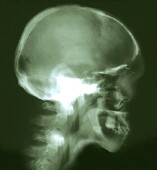
TUESDAY, Nov. 10 (HealthDay News) — Exposure to several common pathogens may increase the risk of having a stroke, a new study shows.
Led by Dr. Mitchell Elkind, an associate professor of neurology at Columbia University Medical Center in New York City, the research team found that the pathogens Chlamydia pneumoniae, Helicobacter pylori, cytomegalovirus and herpes simplex virus 1 and 2 may be implicated in accelerating arterial disease, which in turn increases the risk of stroke.
The team’s work appears in the Nov. 9 online edition of the Archives of Neurology, and will be published in the January 2010 print issue of the journal.
“These are infections that regularly pop up when we study heart disease,” said Elkind. “They are very common in the population.”
Scientists are not completely sure how the pathogens harm arterial function, but several theories offer suggestions. One possibility is that chronic infection leads to inflammation in the blood vessels, which can constrict blood flow. Another possibility, said Elkind, is that the pathogens disrupt the normal functioning of the arterial walls.
Strokes occur when there is a disruption in the blood supply to the brain, such as a blockage in an artery or other blood vessel. When this happens, brain cells begin to die, causing brain damage and even death. Common functions affected or lost during a stroke include speech, movement and memory.
Stroke is the third-leading cause of death in the United States, according to the National Stroke Association. Strokes have many causes, but it is widely known that certain risk factors increase the chances of having a stroke. These include high blood pressure, diabetes, high cholesterol, smoking and obesity.
In recent years, evidence has been uncovering the role of pathogens in cardiovascular disease, particularly the pathogens featured in Elkind’s research. Scientists reported several years ago that untreated gum disease and other oral infections can spread and cause heart disease.
Elkind’s study tracked 1,625 adults from a multi-ethnic community in Manhattan for 7.6 years. During that time, 67 patients suffered a first stroke. Even taking into account other risk factors, such as high blood pressure and diabetes, Elkind’s team found that the majority of the patients tested positive for one or more of the suspected pathogens.
“Each individual infection was positively, though not significantly, associated with stroke risk after adjusting for other risk factors,” the researchers wrote. “The infectious burden index was associated with an increased risk of all strokes after adjusting for demographics and risk factors.”
It is too early to tell which pathogens contributed to the strokes, to what extent they contributed and how they contributed (through simple exposure or chronic infection), said Elkind. What’s more, there may be other pathogens involved that were not included in the study, he added.
It is also too early to make any clinical recommendations. If scientists conclusively determine that pathogens are capable of causing strokes years after people come in contact with them, possible treatments may include wider and longer use of antibiotics, Elkind added.
Dr. Kishore Ranade, a neurologist affiliated with the Mount Kisco Medical Group in New York, said he was impressed with the findings. He suspects that pathogens work with other risk factors to cause strokes.
“Cumulative data have been suggesting that pathogens play a role in heart disease in general,” said Ranade. “And what’s bad for the heart is bad for the brain.”
More information
The National Stroke Association has more on strokes, their causes and treatments.

